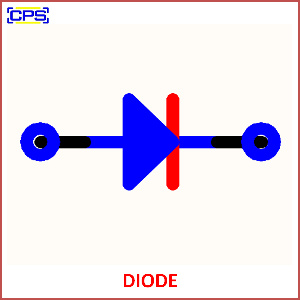A diode is a two-terminal electronic component that allows current to flow in one direction only, offering low resistance in the forward direction and high resistance in the reverse direction. It acts as a one-way valve for electrical current.

Key Features of a Diode:
- Structure:
- Consists of a p-n junction, where a p-type semiconductor is joined with an n-type semiconductor.
- Terminals are called anode (positive) and cathode (negative).
- Forward Bias:
- When the anode is more positive than the cathode, the diode conducts current.
- Reverse Bias:
- When the cathode is more positive than the anode, the diode blocks current (except for a small leakage current).
Types of Diodes:
- Standard Diode: Used for rectification in power supplies.
- Zener Diode: Allows reverse current flow at a specific breakdown voltage, used for voltage regulation.
- Light Emitting Diode (LED): Emits light when forward-biased.
- Schottky Diode: Low voltage drop, used in high-speed switching.
- Photodiode: Generates current when exposed to light, used in sensors.
Applications:
- Rectification: Converts AC to DC in power supplies.
- Signal Demodulation: Extracts information from modulated signals.
- Voltage Regulation: Stabilizes voltage in circuits.
- Switching: Used in logic circuits and high-speed applications.
- Protection: Prevents damage from reverse polarity and voltage spikes.
Diodes are fundamental components in electronics, providing functionality in rectification, signal processing, and circuit protection.
